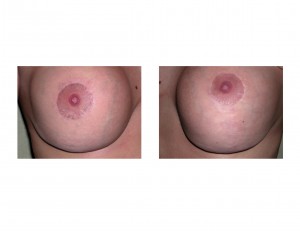Background: While breast augmentation will produce an immediate and significant change in the size of the breasts, it is important to remember that it does so with the implantation of a medical device. As such there are always the risk of complications with any implanted device. One of the most well known complication risks of breast implants is capsular contracture. This is the excessive development of scar tissue around the implant that can create variable degrees of breast firmness and implant malpositioning.
While there are several known factors that can cause breast implant contractures (hematoma and infection), many cases have no known identifiable cause. It is known that the risk of capsular contracture is higher when the implants are placed above the muscle as opposed to a submuscular pocket. It is presumed that the regular motion of the overlying pectoralis muscles acts as a form of massage on the implant capsule that prevents excessive thickening of it.
The successful treatment of breast implant contractures is known to be difficult and fraught with a significant risk of recurrence. Release or removal of the breast implant scar through capsulotomies and capsulectomies does not always prevent recurrence as new excessive scar formation may occur in its place. Implant repositioning to an under the muscle location can be very effective for subglandular breast implant contractures.
Case Study: This 33 year-old female was seen with a history of seven prior breast implant procedures. She originally had saline implants placed above the muscle combined with a periareolar lift. Her subsequent six surgeries were done for implant enlargement, capsulectomies for contractures and areolar scar revisions. Despite these efforts she was left with wide periareolar scars, hard breasts (Grade III capsular contractures) and breast mounds that hung unnaturally off of her chest wall.



Case Highlights:
1) Recurrent capsular contracture is a difficult breast implant problem for which there is no one single treatment method that cures it every time.
2) One successful capsular treatment method for subglandular breast implant contractures is repositioning the implants to a submuscular position.
3) Minor amounts of breast lifting are more successfully done by a vertical lift than a periareolar technique.
Dr. Barry Eppley
Indianapolis, Indiana


